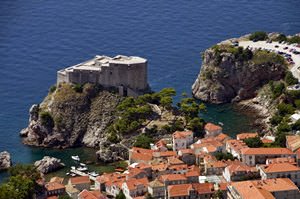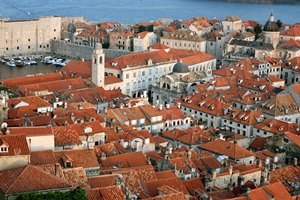 The landmarks of Dubrovnik are not limited to the presented 7 architectural sights. A curious traveler will find thousands of exciting places here. However, below we present the most impressive and striking architectural sights of Dubrovnik, which should be noted at first - Walls of Dubrovnik, Franciscan monastery, Dominican monastery, Dubrovnik Cathedral, Saint Blaise Church and many others. In this unusual virtual tour, you will see the photos and read the facts on each monument. But, most importantly, you will be able to fly over each landmark, and to see the whole architectural ensemble of Dubrovnik in 3D format from the sky.
The landmarks of Dubrovnik are not limited to the presented 7 architectural sights. A curious traveler will find thousands of exciting places here. However, below we present the most impressive and striking architectural sights of Dubrovnik, which should be noted at first - Walls of Dubrovnik, Franciscan monastery, Dominican monastery, Dubrovnik Cathedral, Saint Blaise Church and many others. In this unusual virtual tour, you will see the photos and read the facts on each monument. But, most importantly, you will be able to fly over each landmark, and to see the whole architectural ensemble of Dubrovnik in 3D format from the sky.
Walls of Dubrovnik, Dubrovnik
Location on the map:  Facts:
Facts:
» Dubrovnik is famous for its shield in the form of 2-kilometer fortress walls. The complex is located on the rocky bank. There are additional fortifications in some places. » Starting from the historic center, the walls create a circle and turn the city into an impregnable fortress. The fortification was constructed in the 10th century. The limestone walls have been repainted many times for the last centuries.
» They gained their current appearance in the 16th century. The walls are 6 m thick and 25 m high. To strengthen the defense, additional fortifications (bulwarks), strongholds, and lookout towers were attached to the corner walls.
» There have never been such powerful fortifications in the whole Mediterranean district.
» From the outside, the big construction looks like a range of semi-circular towers with fortresses. There is the sculpture of St. Blaise, the patron of citizens, atop one of the tower.
» One of the fortresses had been built for almost 80 years. Its top is decorated with a stone crown. Fort Bokar was aimed at repelling the enemies’ attacks from the main gate, moat, and bridge.
» You can see the city center from top of the fortress walls. The construction has another interesting feature: if you go it counterclockwise around, you will make a detour, but if you go clockwise, you will see the grille.
Franciscan monastery, Dubrovnik
Location on the map:  Facts:
Facts:
» The Franciscan Monastery is the complex of churches. Originally, the buildings were located beyond the city. Monks moved outside the walls of the city due to frequent military conflicts. » The new monastery started to be built in 1317. It was destroyed by a strong earthquake. Only the southern entrance was not damaged. Then, the building was restored.
» The part of the arched wall depicts the Virgin Mary mourning Jesus. She is surrounded by saints. God the Father is above her.
» There is the sculpture of risen Christ above the central altar in the room. The podium is framed with patterned marble columns.
» In the church, there are the ashes of the South Slavic poet, Ivan Gundulic.
» In the Franciscan Monastery, there are closed bypass galleries. There are 120 octagonal pillars in one of them. Their peaks are different: the head of a man, an animal, or a flower.
» In the center, there is a fountain with sculptures of St. Francis.
» The second part of the cloister is living quarters.
» There are also a pharmacy and a library. Its collection includes over 70 thousand books. There are 1200 books of historical value. The monastery museum presents liturgical items and jewels.
Dominican monastery, Dubrovnik
Location on the map:  Facts:
Facts:
» There is the Dominican Monastery in the eastern district of the city. It had been built for several centuries. It is one of the fortifications. » All the laymen of the city contributed much to the construction by making donations for the temple.
» The earthquake of 1667 damaged the building much.
» The small part of the lodge built in the 15th century is decorated as a garden.
» The monastery includes a working museum. It presents the collection of paintings dating back to the 14th century. One of them depicts the patron of the city, Blaise, holds the miniature of the city of the 16th century in his hands.
» There are many three-arch windows. The construction has three arched doorways along its length. The outer walls are not decorated. There are multiple holes and niches in the inner walls, stone pieces of furniture, gravestones, and a carved stand for reading the Scripture.
» The chapel of the 14th century and the library have been preserved. There are also the first print editions in Europe.
» The monastery is also famous for the crucifix and the wall fresco above the main altar.
» In the patio, there is a garden and a stone Gothic well.
» There is an art gallery at the site of the old chapel. It presents modern paintings.
Dubrovnik Cathedral, Dubrovnik
Location on the map:  Facts:
Facts:
» In 1981, the masonry of the older building was found during the restoration of Saint Mary’s Cathedral. After studying architectural features, researchers concluded that the building date back to the 6th-8th century. This proves that there was a developed settlement at the site of modern Dubrovnik. » The cathedral resembles the Latin cross (the vertical line is longer the horizontal one). 3 prolonged rooms are crowned with a painted dome. New annexes are attached to the halls.
» The precious values here is the painting of Tiziano (1552) and canvases of the 16th-18th centuries.
» St. Blaise (the Christian martyr) is the patron of the city. His remains are resting in the cathedral. There is also the part of the cross from Golgotha, on which Jesus was tortured.
» The building belonged to the Dubrovnik Republic. It was unlocked with keys that different people in power had.
» In the cathedral, there are unusual paintings of Christ, for example, one of them depicts him on the back of the donkey.
» Three domes seen from afar are very interesting.
» The treasury of the House of God presents the collection that includes 200 religious artifacts.
» The temple is open for visitors.
Saint Blaise Church, Dubrovnik
Location on the map:  Facts:
Facts:
» The gilded statue of Saint Blaise was cast in the 15th century and placed on the roof of the cathedral named after him. He holds the miniature of the city in his hands. He was exalted in 971. » According to the chronicles, the priest had the vision of Saint Bacchus who came as an elder with a long waiving beard. He held a rod in his hands and wore a high miter. The prophet warned about the attack of the sneaky Venetians wanting to conquer the city.
» Blaise had been declared the defender and patron of the city since that time. You can see his profile on banknotes, city stamps, and the republican flag.
» On the day of his worship, 3 February, there is the festive procession of worshipers with icons, crosses and the box with the bones of the saint who died in agony for his faith.
» In 1715, the facade was made in the baroque style that features pretentious architectural elements. The entrance is a wide staircase. The dome has the shape of a huge half-sphere. Stained glass windows give an unusual light.
» Near the main altar, there is an organ surrounded by paintings and icons in gilded frames. They depict the saints.
Rector Palace, Dubrovnik
Location on the map:  Facts:
Facts:
» The Rector’s Palace is the residence of princes. Traditionally, the great person lived and worked here all the time. It was forbidden to leave the residence for personal purposes. The stamped inscription above the entrance says the same, “...serve only the state”. » For a full-fledged activity, there were rooms for the nobles and servants, as well as premises services as a conference hall or a courtroom.
» Near them, there was a dungeon and a warehouse for ammunition and weapons.
» On the top floor where the prince lived, the keys to the city gate were kept. He locked it at night and unlocked in the morning himself. The rite symbolized the safety of citizens.
» In the east wing, there was a court chapel and a guardhouse. Their windows have a view of the sea. Here, you can see preserved pieces of furniture of that time and antique items and paintings.
» The royal residence is a single-storey building with four annexes. They surround a patio. It is linked with the other courtyard where the monument to the sailor of the Republican period is placed by the gallery.
» Classical music concerts are held in the atrium.
» Today, the palace serves as a museum. The Rector’s Palace was built in the 15th century.
Sponza Palace, Dubrovnik
Location on the map:  Facts:
Facts:
» At different times, the palace served not only as the prince’s residence. It served as a treasury, a customs house, a school. Here, coins were minted, people of art held literary meetings. It also served the needs of the bank. » Today, there is the archive of national importance on the ground level. Precious historical documents dating back to the 12th century are kept here. Over a hundred thousand papers tell about business relations with other countries.
» In the local museum in the palace, there is an exhibition that tells about tragic events during the defense of the city in 1990.
» There is the statue of the rich sailor (the 17th century) in front of the entrance. He made his will for the republic.
» Annual summer festivals have already become a tradition.
» The palace built in 1522 is a big rectangular building with a patio. The facade is decorated with sculptures and relief masonry. On one of the walls, you can see a medallion with twisted initial letters of the name of Christ.
» It is suggested that the building was built at the place where the rainwater accumulates in the special vessel. It is called Spongia, which means “porous”.










